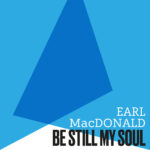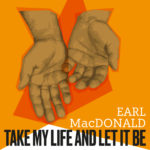In this article, “Jazzified Hymns,” I’ll dissect each song from my new album, Consecrated. Lyrics considerably impact my musical arranging choices, so I’ll start there. Then, I’ll get to the jazzifying part. [This will be added shortly.] To jazzify means “to make jazzy.” So, I’ll delve into the harmonic and rhythmic choices I applied to each piece, to add some jazz seasoning. Videos will be added to further demonstrate my arranging techniques, as they are completed.
1. Be Still, My Soul
 This reworking of Sibelius’ Finlandia hymn acknowledges the reality of difficult life circumstances. But contrary to typical anxious, worrisome responses, it urges being still and trusting in God. The loping jazz groove and haunting muted trumpet suggest a solitary walk on which an introspective conversation with oneself might take place.
This reworking of Sibelius’ Finlandia hymn acknowledges the reality of difficult life circumstances. But contrary to typical anxious, worrisome responses, it urges being still and trusting in God. The loping jazz groove and haunting muted trumpet suggest a solitary walk on which an introspective conversation with oneself might take place.
The balance between the song’s optimistic message and the recurring mention of a soul ill at ease, make the piece especially relatable. But because every stanza begins with “be still, my soul,” it is clear that a very real struggle persists for the lyricist. Although we don’t know the source of her distress, we can empathize and understand. There’s no getting around it; life is hard. In self-conversation (a practice to which I can also relate!), she offers words of encouragement based on her deep understanding of the scriptures. Ultimately this is a song of hope.
I suspect Psalm 118 inspired this song, at least in part. This passage, like the hymn’s lyrics, serves as a reminder for where we can place our trust and take refuge.
vs5-7a: “Out of my distress I called on the Lord; the Lord answered me and set me free. The Lord is on my side; I will not fear. What can man do to me? The Lord is on my side as my helper….”
vs 8-9: “It is better to take refuge in the Lord than to trust in man. It is better to take refuge in the Lord than to trust in princes.”
vs29: “Oh give thanks to the Lord, for he is good; for his steadfast love endures forever.”
2. O God of Love, Grant Us Your Peace
There is a powerful, present-day relevance in this song. Many things in the world threaten to rob us of our peace, such as COVID-19, racial tensions, political strife, and increasingly pronounced divisions.
I find this song refreshingly authentic amid the glut of joyful praise songs more frequently heard in churches. Through his prayer, the song’s protagonist honestly expresses that all is not well. In fact, things down here are a mess! And as we face the daunting realities of life, we could benefit from some Devine help and peace. Sentiments like these are rarely expressed in Sunday morning singing these days. I don’t know how contemporary Christian music became so emotionally and functionally one-dimensional. Joy, worship and adoration have their place, but so do songs of lament and petition, which have all but vanished from the church’s repertoire.
To establish a setting of disquietude, the song’s main rhythmic vamp is derived from the phrygian mode. The inner turmoil referenced in the lyrics is underpinned by the tension found within the mode, with it’s half-step rub between the first and second note.
I was careful not to overwrite this arrangement. Very little was given to the band outside a basic structural sketch. I asked Kris to play soprano sax and I gave him no fixed, written lines to play. I wanted to evoke the the loose, improvised, angst-tinged vibe of the John Coltrane Quartet.
3. Sweet Hour of Prayer
The hymnist poetically expresses the joy, comfort and blessing he experiences in the act of private prayer. In my musical arrangement I sought to capture a correspondingly gentle, magical, intimate atmosphere.
4. Holy, Holy, Holy
Holiness, as I understand it, is what separates God from all other beings. The term encompasses qualities like omnipresence, omniscience, and omnipotence, along with His exceptionality and faultless nature. I wanted my rendition to convey majesty, reverence, glory and awe. After starting out in a traditional hymn-like manner, a light bossa nova feel was introduced to heighten the expressiveness and create a more expansive, worshipful environment.
5. By Our Love
 Because this song has its own stand-alone webpage, by-our-love.com (complete with an animated short video and articles providing the backstory and musical insights), I’ll be brief here. I used this piece as a vehicle through which to raise questions about the state of American Christianity today. Are Christians known “by our love”? Or collectively, are Christians known for their entanglement in party politics, and their willingness to overlook shortcomings in government leaders, provided they look after “Christian” interests? Are Christians known for embodying 1 Corinthians 13, or are they associated with the opposition of immigrants, Muslims, LGBTQ+ people and anyone who mentions taxing the wealthy? The intertwining of Christianity and political tribalism isn’t just paradoxical; it’s deplorable.
Because this song has its own stand-alone webpage, by-our-love.com (complete with an animated short video and articles providing the backstory and musical insights), I’ll be brief here. I used this piece as a vehicle through which to raise questions about the state of American Christianity today. Are Christians known “by our love”? Or collectively, are Christians known for their entanglement in party politics, and their willingness to overlook shortcomings in government leaders, provided they look after “Christian” interests? Are Christians known for embodying 1 Corinthians 13, or are they associated with the opposition of immigrants, Muslims, LGBTQ+ people and anyone who mentions taxing the wealthy? The intertwining of Christianity and political tribalism isn’t just paradoxical; it’s deplorable.
By Our Love is a brooding, instrumental jazz arrangement of the Christian hymn, “They’ll Know We Are Christians By Our Love.” This version’s dark undertones raise questions about the state of contemporary Christendom, its relationship to politics. Although orchestrated for an 11-piece ensemble, the vibe of the John Coltrane Quartet is evoked in the loping groove and aggressive, modern jazz solo work.
6. Be Still
Kris Allen’s song, “Be Still” is comparable to the meditative, contemplative worship style of music associated with the Taizé ecumenical community in France. In this practice, short chants are repeated at length.
The arrangement unfolds naturally, building and then winding down. There is no designated instrumental solo section without vocals. The vocal remains throughout and doesn’t deviate from the melody. In doing so, it represents stillness, while the band is astir around it.
7. Take My Life, and Let It Be Consecrated
 I sought to enhance the timeless lyrics and distinctive melody of “Take My Life, and Let It Be” by giving it a fresh jazz interpretation. Samba dance rhythms mixed with fiery instrumental solo statements add sparkle and evoke feelings of irrepressible joy.
I sought to enhance the timeless lyrics and distinctive melody of “Take My Life, and Let It Be” by giving it a fresh jazz interpretation. Samba dance rhythms mixed with fiery instrumental solo statements add sparkle and evoke feelings of irrepressible joy.
This song is a prayer of personal surrender. But in this case, surrender doesn’t equate to defeat. Consecrated is one of those odd church words I glossed over for years. Through his writing, the Washington DC pastor, Mark Batterson helped me understand it with his succinct definition, “all in.” Those two words resonated for me.
Over the past five years, circumstances arose which left me at a crossroads. As I grew increasingly disillusioned by the behavior and policies of evangelicals, I seriously considered walking away from my faith and saying good riddance to religion. I’ve grown tired of explaining that “I’m a Christian, but not ‘one of those’ Christians.”
However, this didn’t feel right to me. Jesus wasn’t the problem. I am in no way opposed to his counter-culture teachings. My opposition is to the vast cultural layers that have been packaged and sold as Christianity, which undermine the gospel message. For me, these never fit right.
So, rather than walk away, I try to embrace the process of daily renewal, surrender, seeking truth, and not withholding anything from God. I’ve stopped questioning if I am good enough or ready. In an attempt to take the words of this old hymn to heart, I’m digging back into the scriptures, to rediscover and reclaim my faith.
8. The Love of God
It was the beautiful poetry in the final verse that nabbed me and made me want to arrange this hymn:
Could we with ink the ocean fill, and were the skies of parchment made;
were ev’ry stalk on earth a quill, and ev’ryone a scribe by trade;
to write the love of God above would drain the ocean dry;
nor could the scroll contain the whole, though stretched from sky to sky.
By marrying the lyrics with Vernel Fournier’s unconventional Poinciana drum groove, an equally poetic musical treatment was found. Adding an interlude between verses also gives the listener time digest and process the words.
9. Be Thou My Vision
This 8th century Irish hymn acts as a humble prayer. It expresses a desire to continually refocus and prioritize seeking God. Thematically, it pairs well with “Take My Life and Let It Be Consecrated.” The hymn is sung to the Irish folk tune, “Slane,” which I kept intact melodically. I simply modified the harmonies and added an instrumental formal extension, to frame each verse and create some breathing room and space. The harmonic movement reminded me of improvisations I’ve heard by Wayne Shorter and Joe Zawinul. For this reason, I asked Kris to play soprano sax on this piece.
10. In His Holy Temple
In John 3:30, John the Baptist says “He must increase, but I must decrease.” I decided to take this concept and run with it. My idea was that drums would play the role of God, starting as a small rumble, gradually building all the way to the end. This would represent God’s presence and will, gradually increasing, and ultimately enveloping everyone else. When I told Rogerio that drums would play the role of God in this piece, his response was, “…as well they should!”

